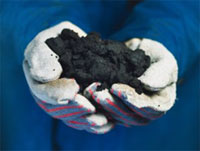Alberta Puts the Heat on Oil Sands Waste
 The Alberta Energy Resources Conservation Board (ERCB) issued a Directive today which develops new industry-wide criteria for managing oil sands waste (known in the industry as “tailings”), and specific enforcement actions if tailings performance targets are not met.
The Alberta Energy Resources Conservation Board (ERCB) issued a Directive today which develops new industry-wide criteria for managing oil sands waste (known in the industry as “tailings”), and specific enforcement actions if tailings performance targets are not met.“Tailings”, or waste from oil sands extraction processes, is generally composed of water, sands, silt, clay and residual bitumen. Alberta’s inventory of fluid fine tailings that require long term containment is now a whopping 720 million cubic metres.
The new Directive requires operators to:
- Prepare tailings plans and report on tailings ponds annually.
- Reduce the accumulation of fluid tailings by capturing fines and placing them in a deposit that is trafficable and,
- Specify dates for construction, use and closure of fluid tailings ponds deposits and file these dates with the ERCB by September 30, 2009.
In past applications, mineable oils sands operators proposed the conversion of fluid tailings into deposits that would become trafficable and ready for reclamation. While operators have applied fluid tailings reduction technologies, they have not met the targets set out in their applications; as a result, the inventories of fluid tailings that require long-term containment have grown. With each successive application and approval, public concerns have also grown.
The Directive is timely. Reports have emerged this past week of a major near disaster involving a potential breach of a retaining dike at TransAlta’s Keephills ash lagoon last summer, where 1.5 billion litres of toxic ash and water are stored. The Calgary herald reports that the RCMP was called in to use a robotic device to examine the unstable slumped wall of the ash lagoon last summer. It took crews nine days after pumping out excess water to stabilize the wall.
Last December In Tennessee an ash lagoon burst releasing an estimated 4.5 billion litres of toxic sludge across 120 hectares that inundated 2 homes and resulted in what clearly will be long term damage to the surrounding eco-system. Ash from coal plants contains toxic heavy metals such as arsenic, mercury, lead, selenium and cadmium.
The Directive is needed according to ERCB because fluid tailings volumes are large and growing. Monitoring tailings performance with applicable enforcement actions will ensure that tailings are well managed and thereby reduce requirements for additional tailings storage capacity. The directive is the first step towards a larger initiative to deliver tailings performance criteria for tailings operations and reclamation.
In December 2008 a major report (11 Million Litres: the Tar Sands’ Leaking Legacy) was released by Environmental Defence, a Canadian advocacy, research and education group alleging that 11 million litres of toxic water leak each day from the giant waste ponds used by the oil sands industry in northern Alberta.

The report was widely quoted and although both the Canadian Association of Petroleum Producers and various regulatory agencies of the Government of Alberta insist that these giant tailings ponds are well designed to protect against such disasters, considerable uncertainty remains.
The ERCB acknowledges that water issues associated with the tailings ponds are complex. While water allocation and water discharges to the surface are well regulated, setting standards for sub-surface water disposal and water use and recycling require a great deal of study and further input.
Consultations undertaken by GLOBE-Net confirm that Alberta Environment regulators are concerned that the separation of water from the post bitumen extraction tailings is taking much longer that originally thought, resulting in growth in the size of the tailings ponds and extended delays in the reclamation process.
The Directive also contains new rules pertaining to Dedicated Disposal Areas (DDAs). DDAs are dedicated to the deposition of captured fines, which are more solid in composition than liquid tailings and must be trafficable and ready for reclamation five years after deposits have ceased. Operators must:
- Reduce the accumulation of fine fluid tailings by capturing a minimum amount of fines (mineral solids with particle sizes equal to or less than 44 micrometres) as proposed in applications or as approved by the ERCB and place the captured fines in a DDA;
- Prepare a plan for every DDA whereby tailings deposits are trafficable and ready for reclamation five years after active deposition has ceased. The plans would be reviewed for the establishment of performance measures by the ERCB, and
- Operate and abandon each DDA in accordance with applications or ERCB approvals.
The Directive was issued in draft form in June 2008. The final version reflects feedback from government, industry, the public and consultations with Alberta Sustainable Resource Development and Alberta Environment.
The new Directive can be found at http://www.ercb.ca/
For More Information: Alberta Energy Resources Conservation Board
You can return to the main Market News page, or press the Back button on your browser.

